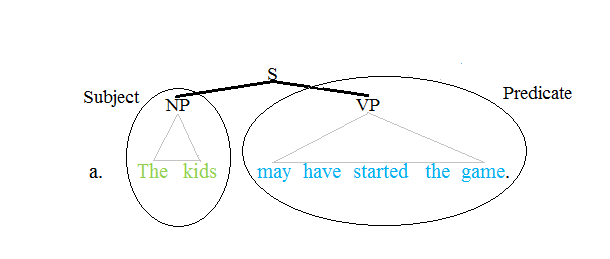Syntax
Traditional grammar
The notion of a predicate in traditional grammar traces back to Aristotelian logic. [2] A predicate is seen as a property that a subject has or is characterized by. A predicate is therefore an expression that can be true of something. [3] Thus, the expression "is moving" is true of anything that is moving. This classical understanding of predicates was adopted more or less directly into Latin and Greek grammars; from there, it made its way into English grammars, where it is applied directly to the analysis of sentence structure. It is also the understanding of predicates as defined in English-language dictionaries. The predicate is one of the two main parts of a sentence (the other being the subject, which the predicate modifies). [a] The predicate must contain a verb, and the verb requires or permits other elements to complete the predicate, or else precludes them from doing so. These elements are objects (direct, indirect, prepositional), predicatives, and adjuncts:
- She dances. — Verb-only predicate.
- Ben reads the book. — Verb-plus-direct-object predicate.
- Ben's mother, Felicity, gave me a present. — Verb-plus-indirect-object-plus-direct-object predicate.
- She listened to the radio. — Verb-plus-prepositional-object predicate.
- She is in the park. — Verb-plus-predicative-prepositional-phrase predicate.
- She met him in the park. — Verb-plus-direct-object-plus-adjunct predicate.
The predicate provides information about the subject, such as what the subject is, what the subject is doing, or what the subject is like. The relation between a subject and its predicate is sometimes called a nexus. A predicative nominal is a noun phrase: in the sentence George III is the king of England, the phrase the king of England is the predicative nominal. In English, the subject and predicative nominal must be connected by a linking verb, also called a copula. A predicative adjective is an adjective, such as in Ivano is attractive, attractive being the predicative adjective. The subject and predicative adjective must also be connected by a copula.
Modern theories of syntax
Some theories of syntax adopt a subject-predicate distinction. For instance, a textbook phrase structure grammar typically divides an English declarative sentence (S) into a noun phrase (NP) and verb phrase (VP). [4] The subject NP is shown in green, and the predicate VP in blue. Languages with more flexible word order (often called nonconfigurational languages) are often also treated differently in phrase structure approaches.[ citation needed ]
On the other hand, dependency grammar rejects the binary subject-predicate division and places the finite verb as the root of the sentence. The matrix predicate is marked in blue, and its two arguments are in green. While the predicate cannot be construed as a constituent in the formal sense, it is a catena. Barring a discontinuity, predicates and their arguments are always catenae in dependency structures. [5]
Some theories of grammar accept both a binary division of sentences into subject and predicate while also giving the head of the predicate a special status. In such contexts, the term predicator is used to refer to that head. [6]
Non-subject predicands
There are cases in which the semantic predicand has a syntactic function other than subject. This happens in raising constructions, such as the following:
| What | makes | you | think | that? | |
| OBJ |
Here, you is the object of the make verb phrase, the head of the main clause, but it is also the predicand of the subordinate think clause, which has no subject. [7] : 329–335

